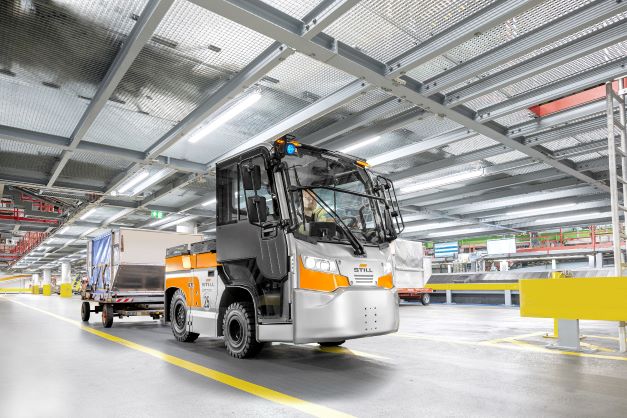STILL raises standards with new truck series
11th January 2022

With the new LXT 120-350 and LXW 20-30 series, STILL says it has not only modernised and expanded its product portfolio of electrically powered tractors and platform trucks but has also raised the safety standard of these trucks to a new level.
In particular, the unique Descent Speed Regulation (DSR) assistance system, a load- and inclination-dependent speed regulation system, provides extra safety and increased handling performance when driving on ramps.
Electric tow tractors and platform trucks have become an indispensable part of the modern working world. Shipyards, car manufacturers, international airports and railway stations, logistics companies, freight forwarders and countless production plants around the world have relied on the qualities of STILL’s tow tractors and platform trucks for many years. Now the Hamburg-based intralogistics provider has once again expanded its vehicle portfolio and geared it up for the future.
The new LXT 120-350 electric tow tractors with towing capacities of between 12 and 35 tonnes and the LXW 20-30 electric platform truck (payloads of two and three tonnes on the load area, towing capacities of six tonnes) offer a wide range of modular equipment options and impress with their performance. Extensive tests in different industries at sometimes very harsh locations have proven that efficiency and top performance can be perfectly combined with these new vehicles.
The STILL engineers are particularly proud of the Descent Speed Regulation (DSR) assistance system they developed. “An absolute world first,” emphasise the two STILL experts Alexander Claus, product manager for tractors, and Janos Poppe, product trainer for tractors. “This unique system not only supports the driver in driving safely on ramps, but also increases the handling performance. With trailer loads of up to 35 tonnes, the drivers always move in accordance with the situation – and at the same time as quickly as possible,” says Poppe.
Depending on the version, the DSR detects the exact inclination on sloping ramps for this purpose, takes the current load weight into account and automatically adjusts the speed to the respective conditions by intervening in the oil bath multiple-disc system. In the basic version, which is installed in all vehicles, the speed is limited manually to a predefined speed via a switch when driving down a slope.
In the optionally available ECO version, the system shows the gradient on the display and automatically limits the speed to a predefined value. In the premium version of the DSR, the automatic speed reduction depends on the gradient and additionally on the towed load. The trailer load is determined by measuring the torque on the drive motors.
“This very innovative method of determining the load, in which we measure the trailer load virtually at the trailer coupling, is so far the only one of its kind in the world and is only used on STILL trucks,” reports Claus, not without pride.
Uncompromised technical equipment
The STILL developers have also come up with something for the other technical components of the new trucks. For example, all the trucks have hydraulic multi-disc brakes on both axles, which enable a particularly high-performance and precise braking process, are wear-free and operate almost completely silently. In addition, the regenerative braking of the electric drive allows energy to be recovered during the braking process. The parking brake is also electric and engages automatically.
The vehicles of the LXT/LXW series are driven by two 10.5kW motors on the rear axle. The 80V three-phase motors are encapsulated and maintenance-free. The intelligent motor control ensures agile driving behaviour and the speed-controlled drive means that there is no loss of speed, even when driving uphill for long periods. The maximum speed of the LXT vehicles without load is 25km/h, the LXW reaches up to 23km/h. The towing tractors and platform trucks can be charged quickly and easily without opening the bonnet thanks to the quick-charge socket or on-board charger.
The new cab is generously designed and offers even tall drivers plenty of headroom and a very spacious footwell. A wide range of seat adjustments ensures a comfortable workplace and offers every driver the right position for fatigue-free work. The driver’s cab itself is mounted on rubber buffers and is therefore vibration-damped and decoupled from the chassis.
The chassis, which is equally damped by extra-long coil springs, offers additional driving comfort and allows first-class road holding. Thanks to the STILL Easy Control colour display, the drivers always have all the important information at a glance – for example the steering wheel position, direction of travel, driving programme, speed, angle of inclination, load display or loading status. The new steering wheel with optional knob allows easy and ergonomic operation of the fully hydraulic steering. Its haptic surface provides a good grip.
Improved visibility
‘All-round glazing’ ensures optimum visibility in the new vehicles. To this end, 23% more window surfaces were installed compared to the predecessor models. Optimised visibility in all directions increases safety and prevents physical damage. The optional reversing camera makes manoeuvring and coupling easier when reversing.
Protection against accidents and breakage of goods is also provided by the Curve Speed Control system, also available as an option, which automatically adjusts the speed during cornering and thus ensures safe cornering. The vehicles can be easily integrated into control systems such as STILL neXXt fleet, the most innovative and powerful web portal for fleet optimisation of industrial trucks, via an optional interface. All relevant information for quick analyses or optimisation measures are thus bundled in just one tool.
Other optionally available safety features include the STILL Flashlight, Safety Light 4Plus, FleetManager and the intelligent acoustic warning signal, the volume of which is always 10dB higher than the ambient volume. With this system, passers-by and other drivers or operators are always warned of the vehicle at the right volume, without creating an unnecessarily high noise level for the driver and the person being warned.

